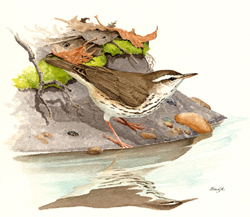Find a Bird - BBA1
Breeding Bird Atlas 1 Species Accounts
Louisiana Waterthrush
Seiurus motacilla
Egg Dates
not available
Number of Broods
one

The Louisiana Waterthrush is a fairly common summer resident in the hill country of central and western Massachusetts but becomes decidedly rare east of Worcester County. It is absent entirely from Cape Cod and the Islands. General expansion northward and eastward has been documented in the historical period. It was first found nesting in Massachusetts on Mount Tom, Holyoke, in 1869. Forbush’s (1929) map, though giving fewer nesting records, is remarkably similar to the Atlas map and documents that, even before 1930, eastward movement in the hills was well underway. The greater number of confirmed nestings in the Atlas period may, in part, be an artifact of more determined systematic coverage of the state than was the case in the years before 1930.
Louisiana Waterthrushes arrive in mid-April. Their wild, ringing, sweet song carries for a considerable distance through the still-leafless April woods. The song characteristically starts with three loud, clear, slurred, and downward-inflected notes and ends as a jumble of musical notes. Like its congener, the Ovenbird, this species also reportedly has a complex and little-known flight song, which is sometimes given at night. Singing continues through June and is rarely heard to early August. In territorial defense, waterthrushes sometimes pour out song repeatedly in flight.
The preferred habitat is along the Blackfly- and mosquito-infested reaches of both swift and sluggish brooks and streams running through deep mixed woodlands. Unique among wood-warblers, pairs occupy long linear territories that approximate the thread of the stream, sometimes for several miles of quiet sluggish headwater swamps as well as swiftly flowing reaches. Territories are often so long that singing birds cannot be heard from one end to the other.
Typically, within these linear territories, the birds spend most of their time foraging about low in the stream itself or on the stream’s banks. Birds walk nonchalantly about, rather than hopping, and wag their tails continuously. The birds sing while walking about, during flight up and down the territory, and periodically when elevated on tree perches up to 30 feet in height. Regular singing perches do not seem to be employed.
Nest sites are usually in crevices or hollowed-out areas of perpendicular, often moss-covered stream banks. Sometimes nests are built among the upturned roots of fallen trees or other debris in the stream. Nests are usually low, sometimes only 6 inches above running water. They are constructed externally of grass, rootlets, moss, and dead leaves and are lined with finer grasses, fern material, and various hairs. Clutches of four to five eggs are common, with as many as seven reported. Massachusetts egg dates are not available. Connecticut egg dates are May 6 to June 12 (EHF). Incubation is accomplished mostly by the female and takes 12 to 14 days. Although the behavior is rarely witnessed, the adults will flutter along the ground with outstretched wings to distract intruders from young. Adults carrying food, presumably to nestlings, have been observed in Massachusetts from June 3 to June 7, and fledglings have been seen from June 10 to June 26. A family group of six was reported on June 23 (Kellogg, Meservey).
The Louisiana Waterthrush begins departing New England as soon as its young can fly, which sometimes may be as early as mid-June. Thus, in some years, this early-arriving and highly specialized wood-warbler may be moving southward at a time when many summer residents have barely begun to nest. Scattered reports continue throughout July and into August. Its wintering grounds lie mostly south of the United States from the West Indies and Mexico through most of Middle America to eastern Panama, northeastern Colombia, and Venezuela.
Map Legend and Data Summary
Atlas 1 data collected from 1975-1979


Note: uncommon on hillside streams of central and western regions; rare and local eastward
Bradford G. Blodget



